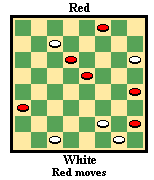 Red (to move) is a piece ahead, and can draw in several
ways, for instance by returning the piece with 15-19 or 15-18. But perhaps it
won't hurt to try for a win:
Red (to move) is a piece ahead, and can draw in several
ways, for instance by returning the piece with 15-19 or 15-18. But perhaps it
won't hurt to try for a win:Return to my Checkers pages
Go to my home page
© Copyright 2004, Jim Loy
You may print this and show it to
others. But, this article will eventually be part of a book that I am writing.
So, please do not distribute it widely.
If you need help reading checkers notation, please print out the numbered board.
 Red (to move) is a piece ahead, and can draw in several
ways, for instance by returning the piece with 15-19 or 15-18. But perhaps it
won't hurt to try for a win:
Red (to move) is a piece ahead, and can draw in several
ways, for instance by returning the piece with 15-19 or 15-18. But perhaps it
won't hurt to try for a win:
10-14 6-2 15-18 (14-18 or 15-19 return the piece for a draw) 2-6 18-22 6-9 14-18 (14-17? 9-13 WW) 9-13! (27-24? draw or 9-14 22-26 draw) 22-25 13-17 25-29 17-14 (if White had a waiting move, and could keep the king on 17, the WW would be easy) 18-22 14-17 22-26 30-23 21-25 17-22 25-30 23-18 30-25 27-23 25-21 17-22 25-30 23-18 30-25 27-23 25-21 23-19 and you see that Red may be in trouble. In fact, this is a WW.
So, Red's attempt to win was suicidal. Any decent player would return the piece earlier, without much thought, for the easy draw. In the diagram, 15-19 is easiest, as it threatens 19-24, forcing White to take the immediate draw.
I know people who emotionally would have to go for the win (Red is a piece ahead, after all). These are aggressive players who hate draws. And they would lose. These people will never be strong checker players. When you are forced to take a draw, take the draw. There are a lot of draws in checkers. You can't avoid them all. And draws are useful in winning matches and tournaments, and they are better than losses.